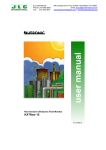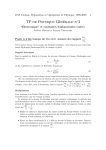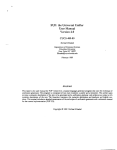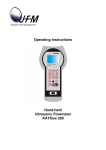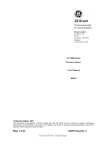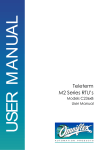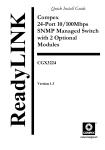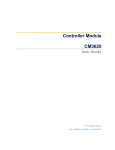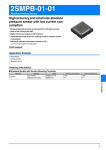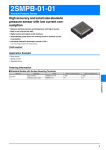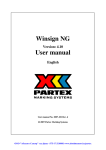Download "user manual"
Transcript
user manual Non-invasive Ultrasonic Flow Monitor KATflow 10 www.katflow.nt-rt.ru M-10-0000-E K A T f l o w 10 s e r i e s По вопросам продаж и поддержки обращайтесь: Тел./факс: +7(843)206-01-48 (факс доб.0) [email protected] www.katflow.nt-rt.ru Page 2 K A T f l o w 10 s e r i e s Contents Introduction.................................................... 4 Principle of Operation.................................... 5 Applications.............................................…... 6 Installation.................................................…. 8 Set up Procedure (KATflow 10-01 only) ..... 12 Alarm Modes................................. 12 Entering the Setup Mode.............. 14 Selecting the Alarm Mode............ 15 Setting the Alarm Set Point.......... 15 Alarm Conditions.......…………….. 16 Current Output............................... 16 Voltage Output............................... 17 Diagnostics.................................... 17 Operation at Elevated Temperatures..........…. 18 Cable Specification......................................… 19 EMC Declaration........................................…. 20 Troubleshooting..........................................…. 21 Technical Specification...............................…. 22 Page 3 K A T f l o w 10 s e r i e s Introduction The KATflow 10 series is a range of non-invasive flow monitors and switches designed for use on most industrial liquid flow applications. The latest, proven ultrasonic techniques are employed to provide repeatable and reliable switching points. The KATflow 10 series can be installed and set up in minutes without disturbing the process it is monitoring. The microprocessor control allows the set up procedure to be completed in a few seconds as well as providing fault diagnosis and alarm indication. There are two models in the range, the KATflow 10-01 is the standard version for use in non-hazardous industrial applications and the KATflow 10-02 is a hazardous area version (EEx m) for use in Zone 1 & Zone 2 hazardous areas. The KATflow 10-01 provides a 4 to 20 mA output, a 0 to 10 V analogue voltage output and a programmable volt free relay contact as standard. The KATflow 10-02 provides a 0 to 10 V analogue voltage output as standard. Note: The KATflow 10-01 must be powered by a fused power supply, the recommended dc fuse rating is 250 mA. The KATflow 10-02 must be powered by a fused power supply, the recommended dc fuse rating is also 250 mA. In addition the dc fuse must have a rated breaking capacity of 4000 A. Page 4 K A T f l o w 10 s e r i e s Principle of Operation The KATflow 10 series uses a proven ultrasonic technique. An ultrasonic signal is transmitted into the fluid and is reflected back off any solid particles or air bubbles in the fluid. If the particles are moving the signal will be reflected back at a slightly different frequency than the transmitted signal. The difference in the frequencies between the received and transmitted signals, or frequency shift, relates directly to the speed that the solid particles are travelling at in the pipe. The KATflow 10 series converts this frequency shift into an analogue voltage which is proportional to the flow rate. This analogue voltage is then scaled to 0 to 10 V and buffered to provide the analogue output voltage. KATflow 10-01 only - The 4 to 20 mA output is scaled directly from the analogue voltage output (4 mA = 50 mV & 20 mA = 10 V). The relay switching point is determined from the analogue voltage signal. Page 5 K A T f l o w 10 s e r i e s Applications For the best results the KATflow 10 series can be applied where: • there is a full pipe flow. • the pipe material is steel, iron, plastic or glass but not concrete, rubber or flexible plastic pipes. • the pipe diameter is greater than 40 mm, and less than 400 mm. • the pipe wall thickness is less than 10 mm. • the flow velocity is between 0.3 m/s and 3.5 m/s. See the table opposite for minimum and maximum flow rates. • the ambient temperature is between -40 oC and +85 oC. • if the intended application is in a designated hazardous area (zone 1 or 2) then the KATflow 10-02 must be used. • The solids concentration in the fluid is greater than 100 parts per million. (e.g. not pure or distilled water). The solids particles must be greater than 100 µm in diameter. Page 6 Page 7 Pipe ID inches 1.6 2 3 4 6 8 10 12 16 Pipe ID mm 40 50 75 100 150 200 250 300 400 26000 14750 10250 6600 3700 1650 920 410 170 76 53 33.5 19 8.4 4.75 2.1 1600 880 620 400 220 100 56 25 Table 1. Minimum and Maximum Flow Rates 2850 1275 880 560 315 140 79 35 750 335 233 147 84 37 21 9.2 7050 3870 2730 1760 970 440 250 110 Min. Flow Max. Flow Min Flow Max. Flow Min. Flow Max. Flow ltr/min ltr/min m 3/hr m 3/hr Imp. Gall/ Imp. Gall/ min min 22.5 265 1.35 16 5.9 70 K A T f l o w 10 s e r i e s K A T f l o w 10 s e r i e s Installation • Before installation ensure that the application and intended mounting position are compatible with the requirements in the previous section and that the power supply is capable of supplying the rated voltage and current (22 to 36 V dc @ 150 mA) and is fused correctly (250 mA). • NB: The KATflow 10-02 power supply must have a dc fuse with a rated breaking capacity of 4000 A. • The unit should be installed on a straight section of pipe at least 4 pipe diameters from any restrictions to flow or sources of fluid turbulence, e.g. pumps etc. • The point at which the sensor attaches should be cleaned down to bare metal / plastic etc. • On horizontal pipes it is preferable to mount the sensor between the 1 o’clock and the 5 o’clock position on the pipe to ensure that the ultrasound is easily transmitted into the fluid and not into an air pocket (top of pipe) or through a layer of sediment (bottom of pipe), see figure 1. Figure 1. Correct Positioning on horizontal pipes Page 8 K A T f l o w 10 s e r i e s Figure 2. Correct alignment on pipe • The sensor is strapped to the pipe using suitable metal banding (11 mm wide maximum). Prior to mounting the sensor on the pipe ensure that the length of banding will go around the pipe and then thread one end through the slot in the base of the sensor. • Before clamping the sensor, smear some silicon grease (Dow Corning DC4 or similar) along the bottom of the sensor, where it touches the pipe. This is to provide a good acoustic path for the ultrasonic signal between the sensor and the pipe. • Thread one end of the banding through the grub screw attachment and fit the grub screw. Tighten the banding as tight as possible whilst checking that the sensor is aligned along the pipe axis, see figure 2. • Note: Do not install a KATflow 10 within 3 m of another KATflow 10 on the same section of pipe. • KATflow 10-01 only - Undo the four captive screws and remove the sensor lid. • KATflow 10-01 only - Feed a multi-core cable, (see caPage 9 K A T f l o w 10 s e r i e s Figure 3. Cable End Preparation ble specification page 19) with the end already prepared, see figure 3, through the cable gland and wire the sensor as shown in figure 4. • KATflow 10-01 only – Tighten the cable gland. Figure 4. KATflow 10-01 wiring details Before applying power to the sensor check that the power supply is rated at 22 to 36 V dc, 150 mA and is suitably fused (dc side) with a 250 mA fuse. In addition, on KATflow 10-02 applications, the dc fuse must have a rated breaking capacity of 4000 A. Page 10 K A T f l o w 10 s e r i e s Note: The KATflow 10-02 is fitted with an integral cable, it is not possible to remove the lid. The sensor should be connected as shown in figure 5 Figure 5. KATflow 10-02 wiring details Apply power to the sensor. • KATflow 10-01 only - both LED’s should be illuminated for 30 secs. (Do not attempt to program the unit during this ”warm up” period - wait until one or both LED’s go out). • KATflow 10-01 only - after the initial start up, pressing the red push button briefly (< 1 sec) will flash the green LED and confirm that the unit is operational. Page 11 K A T f l o w 10 s e r i e s Set up Procedure (KATflow 10-01 only) Note: There is no set up procedure for the KATflow 10-02 . Once the unit is wired up and the power applied, the analogue voltage output provides a signal that is proportional to the flow rate in the pipe. The following section describes how the KATflow 10-01 is set up. It assumes the installation is complete as described in the previous section. All the set up functions are performed using the red push button and the two LED’s (one green, one red). The set up consists of learning and storing the normal flow characteristics, selecting the Alarm Mode and setting the Alarm Set Point. The Alarm Modes are described opposite, the Alarm Set Point is set as a percentage of the normal flow reading. Even if you do not intend to use the relay output you still need to complete the set up procedure as several internal settings need to be configured at this stage. Alarm Modes (KATflow 10-01 only) There are 3 Alarm Modes that can be set: alarm low, out of bounds alarm and alarm high. Alarm Low - in this mode the KATflow 10-01 will go into alarm when the flow rate falls below the alarm set point, see figure 6, e. g. to detect pump dry running. Out of Bounds Alarm - in this mode the KATflow 10-01 will go into alarm when the flow rate falls outside an upper and lower alarm set point, see figure 7, e.g. to detect when a flow rate goes Page 12 K A T f l o w 10 s e r i e s Figure 6 - Alarm Low operating mode outside the normal flow range. Alarm High - in this mode the KATflow 10-01 will go into alarm when the flow rate rises above the alarm set point, see figure 8. For example to detect when a flow exceeds a safe limit. Figure 7 - Out of bounds alarm mode Once the KATflow 10-01 has been installed on the pipe and all the necessary electrical connections made, (“Installation”, page 8) the unit has been powered up and the “warm up” period has Page 13 K A T f l o w 10 s e r i e s Figure 8 - Alarm High operating mode finished, the set up procedure can commence, if the lid has not been removed you will need to remove it now. Before proceeding with the set up, decide which Alarm Mode and Alarm Set-Point are required. • Set up the normal flow condition in the pipe and allow time for the flow to stabilise before starting the set-up procedure. Entering Setup Mode (KATflow 10-01 only) • Press and hold the red push-button, the green LED will flash. The KATflow 10-01 will now record and store a value for normal flow, this value will be scaled to 100%. • When the green LED stops flashing (approximately 3 seconds) and stays illuminated you can release the button. You are now ready to set the Alarm Mode. The sensor will remain in this mode until the button is pressed (or time out after 10 seconds). Page 14 Selecting the Alarm Mode (KATflow 10-01 only) K A T f l o w 10 s e r i e s • Select 1 of the 3 Alarm Modes (see previous pages for an explanation) by pressing the button 1, 2 or 3 times. Each button press will cause the green LED to extinguish for 0.5 seconds as confirmation. ⇒ Alarm Low Mode is entered by pressing the set-up button once. ⇒ Out of Bounds Alarm Mode is entered by pressing the set-up button twice. ⇒ Alarm High Mode is entered by pressing the set-up button three times. • Once the required mode has been entered the red LED will flash for a couple of seconds, then the green LED will flash 1, 2 or 3 times to confirm which alarm mode has been set. Wait until both LED’s are extinguished before setting the Alarm Set Point. Setting the Alarm Set Point (KATflow 10-01 only) • The Alarm Set Point is set by pressing the button once for 10%, twice for 20%, three times for 30% etc. up to a maximum of 10 times for 100%. The green LED will flash each time you press it as confirmation. ⇒ Example - a 30% alarm set point is selected. In alarm low mode a 30% set point will trigger an alarm if the flow goes below 70% of normal flow. In out of bounds alarm mode a 30% set point will trigger an alarm if the flow exceeds 130% of normal flow or falls below Page 15 70% of normal flow. K A T f l o w 10 s e r i e s In alarm high mode a 30% set point will trigger an alarm if the flow exceeds 130% of normal flow. • If the requested Alarm Set Point cannot be set it will default to the closest possible. At some low flow rates the resolution of the flow measurement is insufficient to allow reliable switching if a 10% or 20% Alarm Set Point is requested, the Alarm Set point will then default to 30%. • After the last button press wait 3 seconds until the green LED flashes once for each 10% of the Alarm Set Point that has been set. The calculated switching alarm set point will now be stored in the sensor memory. • The red LED will now flash once. Set up is now complete. • If at any point a mistake is made you can re-enter the set up mode by pressing and holding the push button until the green LED stops flashing. Alarm Conditions (KATflow 10-01 only) When the Alarm Set Point is crossed the sensor will: ⇒ flash the green LED ⇒ de-energise the SPCO relay (the relay is energised during normal operation). Current Output (KATflow 10-01 only) • The range of output current is 4 mA to 20 mA. 4 mA corresponds to a zero flow condition and 20 mA = ap- Page 16 prox. 3.5 m/s flow velocity Voltage Output K A T f l o w 10 s e r i e s • The range of output voltage is 50 mV to 10 V. The scaling of the voltage output is fixed, 50 mV corresponds to a zero flow condition and 10 V = approx. 3.5 m/s flow velocity Diagnostics (KATflow 10-01 only) There are several fault conditions that the sensor can detect such as insufficient particles in the fluid (e.g. pure water), loss of coupling between the pipe and the sensor or transducer failure. In any one of these fault conditions KATflow 10-01 will: ⇒ de-energise the relay. ⇒ clamp the voltage output to approx. 50 mV - 100 mV. ⇒ illuminate the red LED. In the event of a power failure or circuit failure the sensor outputs will all failsafe i.e. ⇒ the voltage output will drop to 0 V, at all other times the output will have a small offset of approx. 50 mV. ⇒ the current output will drop to 0 mA. ⇒ the relay contacts will de-energise. ⇒ the LED’s will not be illuminated Page 17 If the KATflow 10 series is to be operated in ambient temperatures in excess of 55 0C, the maximum allowable power supply voltage will need to be de-rated according to the graph below. KATflow 10 MAXIMUM INPUT VOLTAGE DE-RATING GRAPH Supply Voltage K A T f l o w 10 s e r i e s Operation at Elevated Temperatures 40 30 20 10 0 -40 -20 0 20 40 60 80 Temperature in C Figure 9. Supply Voltage / Ambient Temperature de-rating graph Page 18 K A T f l o w 10 s e r i e s Cable Specification The cable used should be a shielded multi-core with 4 to 9 cores (dependent upon the outputs used). The scre en must be solidly connected to the housing using the “top hat” in the cable gland as shown in figure 2. KATflow 10 series requires minimum power supply parameters of 18 V dc @ 150 mA at the sensor. In order to determine a suitable cable specification you need to calculate the voltage drop along the cable and subtract that from the power supply output voltage such that: Vsensor = VPSU - Vdrop = > 18 V Vdrop = Cable resistance (ohm / metre) x Cable length (metres) x 0.15. The cable gland fitted will accept cables with an outside diameter of between 6.88 mm and 8.8 mm. Suitable cable conductor sizes are: 4 core - 16/0.2 mm conductors 6 core - 16/0.2 mm conductors 8 core - 16/0.2 mm or 7/0.2 mm conductors 12 core - 7/0.2 mm conductors A cable gland to suit larger cables is available upon request. Page 19 EMC Declaration K A T f l o w 10 s e r i e s The product described in this manual has been tested and complies with the following European standards: EN50081-1 : 1992 Generic Emission Standard - Residential, Commercial and Light Industry EN50082-2 : 1995 Generic Immunity Standard - Industrial Environment. Note: The product is susceptible to fields greater than 4 V/m at kHz and in the band 1.48 to 1.52 MHz. 750 A full declaration of conformity is available upon request. This declaration assumes that the product has been installed correctly as described in this manual. Page 20 Troubleshooting K A T f l o w 10 s e r i e s Symptom The red LED is illuminated after the setup procedure has completed. Remedy ⇒ ⇒ There is no change in the KATflow 10 output for a given change in flow ⇒ ⇒ The LED's are not illuminated ⇒ ⇒ The alarm set point cannot be set to a 10% or 20% band / level at certain flow rates ⇒ The output does not reach 10 V or 20 mA even at maximum flow. ⇒ The mA output is less than 4 mA ⇒ The KATflow 10 cannot detect a flow, check that there is flow in the pipe and that the flow is within the rated flow rates as defined i n Table 1, page 7. Check that the KATflow 10 is correctly aligned on the pipe and the banding is as tight as possible. Check that the application criteria fits with the “Application” section in this booklet. If the application involves very pure or distilled water where the solids concentration is less than 100 parts per mi llion (100 µm diameter minimum) then there may not be enough particles in the flow. Check that the sensor is firmly clamped to t he pipe, a suitable acoustic couplant (i.e. silicon grease) has been used and that the setup procedure has been Press the red button, the green LED should illuminate. Check that the sensor is wired correctly and the At some low flow rates the KATflow 10 will not set 10% or 20% alarm set points as the signal resolution would be too small. In these cases it will default to a 30% setting. The outputs are scaled for a flow rate range of 0.3 to 3.6 m/s, the application flow rate range may not be the same. Check that the power supply is within the range 22 to 36 V dc and is capable of supplying at least 150 mA. Page 21 Technical Specification: KATflow 10 Outputs KATflow 10-01 1 volt free contact, programmable 1A at 30V dc SPCO 4-20 mA auto scaled 0-10 V dc analogue KATflow 10-02 0-10 V dc analogue Power Requirements 22-36 V dc, 120 mA typically Operating Temperatures -40 0C to +85 0C Ingress Protection Rating IP67 (equivalent to NEMA 6) Velocity Range 0.3 m/s to 3.5 m/s Size/Weight Size: 118 mm L x 70 mm H x 65 mm W Weight: 1.5 kg Pipe Diameter 40 mm min. diameter up to 400 mm max. Pipe Wall Thickness up to 10 mm Hazardous Area Approvals EEx m II T6 ( T amb –20 0C to + 80 0C, KATflow 10-02 only) Repeatability / Accuracy ±7.5% of reading, application dependent Housing Material Type 316 stainless steel investment casting CE / EMC Approval Complies with BS EN 50081-1:1992 for emissions BS EN 50082-2:1995 for immunity Bump, Shock & Vibration По вопросам продаж и поддержки обращайтесь: Тел./факс: +7(843)206-01-48 (факс доб.0) [email protected] www.katflow.nt-rt.ru






















